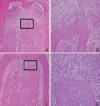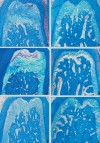Experimental periodontal disease treatment by subgingival irrigation with tetracycline hydrochloride in rats
- PMID: 21308297
- PMCID: PMC3881757
- DOI: 10.1590/s1678-77572010000600017
Experimental periodontal disease treatment by subgingival irrigation with tetracycline hydrochloride in rats
Abstract
Objective: The aim of this study was to compare subgingival irrigation with tetracycline hydrochloride (TTC-HCL) as adjunctive treatment to scaling and root planning (SRP) on induced periodontitis in rats.
Material and methods: In 60 rats, periodontal disease was ligature-induced at the mandibular left first molar. After 7 days, the ligature was removed and all animals were submitted to SRP, and divided into 2 groups according to the following treatment: C (n=30) - subgingival irrigation with 1 mL of saline; T (n=30) - subgingival irrigation with 1 mL of TTC-HCL (50 mg/mL). Ten animals in each group were euthanized at 7, 15 and 30 days posttreatment. The histometric values were statistically analyzed (p<0.05).
Results: In the histometric analysis, at 7, 15 and 30 days, Group T (0.72 ± 0.05 mm², 0.57 ± 0.14 mm², 0.62 ± 0.07 mm²), showed less bone loss (p<0.05) than Group C (1.35 ± 0.25 mm²; 1.40 ± 0.31 mm²; 1.29 ± 0.27 mm²), respectively.
Conclusions: Subgingival irrigation with TTC-HCL was an effective adjunctive treatment for periodontal disease induced in rats.
Figures



References
-
- Adriaens PA, Edwards CA, De Boever JA, Loesche WJ. Ultrastructural observations on bacterial invasion in cementum and radicular dentin of periodontally diseased human teeth. J Periodontol. 1988;59(8):493–503. - PubMed
-
- Akincibay H, Orsal SO, Sengün D, Tözüm TF. Systemic administration of doxycycline versus metronidazole plus amoxicillin in the treatment of localized aggressive periodontitis: a clinical and microbiologic study. Quintessence Int. 2008;39(2):33–39. - PubMed
-
- Baker PJ, Evans RT, Coburn RA, Genco RJ. Tetracycline and its derivatives strongly bind to and are released from the tooth surface in active form. J Periodontol. 1983;54(10):580–585. - PubMed
-
- Christersson LA, Norderyd OM, Puchalsky CS. Topical application of tetracycline-HCl in human periodontitis. J Clin Periodontol. 1993;20(2):88–95. - PubMed
-
- Cosyn J, De Bruyn H, Sabzevar MM. Subgingival application of chlorhexidine in the treatment of periodontitis. Rev Belge Med Dent. 2007;62(4):176–182. - PubMed
Publication types
MeSH terms
Substances
LinkOut - more resources
Full Text Sources
Medical

